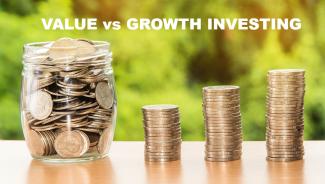
Value or Growth?
Written by Rick Welch
As you develop an investment strategy, it is important to focus on getting size (large, mid and small), sector and region/country right. A broad approach to asset selection allows for adjustment of the composition of the portfolio over time, increasing exposure to those assets most likely to outperform in prevailing market conditions. A tactical adjustment to your asset allocation may involve the consideration of investing styles, like value and growth. At this point, you are probably thinking that the terms, value and growth, are simple enough to avoid confusion in the marketplace. Many investors are quick to assume that value is the opposite of growth – that is not exactly the case, though fundamentally the two investing styles are quite different. While the characteristics that distinguish the two styles are derived from the same data, there are other factors which can blur the lines between what value and growth should mean to the investor.
Value investing targets companies with lower-than-average growth rates for sales and earnings and lower-than-average price-to-earnings (P/E) and price-to-book (P/B) ratios. Typically, value stocks are associated with large, well-established companies that tend to trade at a lower price relative to their fundamentals and pay a rich dividend. Investors buy these stocks in the hope that they will increase in value when the broader market recognizes their full potential. With value stocks, we are often looking at disappointing past results. In some cases, the period(s) of poor performance are considered temporary and suggest that a turnaround opportunity may exist. Some investors mistakenly equate value with cheap. In some cases, stock prices are lower because the company has consistently disappointed investors – in this instance the stock price may be cheap, but not because there is hidden value, rather because there is little demand for the stock. In contrast, growth stocks point to a promising future, with less attention paid to past results. Growth investing targets higher-than-average growth rates for sales and earnings and higher-than-average P/E and P/B ratios. Most growth stocks are more volatile than value stocks and pay out less in dividends. The trade-off for dividend hungry investors is that growth-oriented companies are more likely to reinvest profits in the building or expanding of their business thus creating greater value in the ongoing enterprise and lifting share prices.
So which style is right for you and your portfolio? Value and growth stocks tend to move into and out of favor over time, so a good strategy might be to own both styles in a diversified portfolio. During recessions and the first steps of post-recession recovery, value stocks will often outperform growth stocks. During expansionary times, growth stocks are often the leaders. Not surprisingly, since the financial crisis growth stocks have outperformed value stocks in 8 of 11 years. For 2019 (YTD), the S&P 500 Growth Index has risen 16.51% compared to a return of 12.97% for the S&P 500 Value Index. Predicting if that trend will continue is difficult. Should the Fed continue to ease growth stocks could benefit while a trade deal between the U.S. and China could lead to rising rates and higher commodity prices which could benefit value stocks in the financials, energy and materials sectors.
Notwithstanding the foregoing, the savvy investor should acknowledge that in the asset valuation process value and growth are, in fact, related to each other, not separate and distinct styles or characteristics. In his 2000 annual letter to the shareholders of Berkshire Hathaway Warren Buffett wrote that “investment managers who refer to “growth” and “value” styles as contrasting approaches to investment are displaying their ignorance, not their sophistication. Growth is simply a component – usually a plus, sometimes a minus – in the value equation.”

